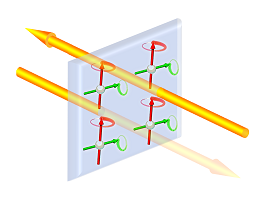The optical properties of a medium can tell us a lot about the interactions inside the material. In an optical absorption experiment the sample is subjected to a light beam and the transmitted intensity is measured, from which the absorption of the sample can be calculated. If we study the absorbed intensity in the function of light frequency, the distance between the energy levels of the system can be determined.
When a photon with a given energy is absorbed (its energy is propertional to the light frequency), it causes a transition of the system between two energy levels of an energy difference corresponding to the photon’s energy. Usually we can assume that the system was in the beginning in its lowest energy state called ground state, thus the frequencies at which absorption occures correspond to the energy levels of the system. Knowing the energy levels, conclusions can be drawn about the interactions between the components of the system.
The energy levels correspond to excitations of the system, for example coordinated vibrations of the crystal lattice (vibration of the atoms with an electric charge) or of the magnetic moments of the atoms. The former can be excited by the electric component and the second one by the magnetic component of the light with adequate polarization. For example a vibration of electric charged ions along the x axis can be excited by an oscillating electric field along the x axis.
In most materials these electric and magnetic excitations are independent of each other, each energy level can be characterized either as electric or magnetic vibration. In contrast, in multiferroics the coupling of electric and magnetic properties manifests itself also in the excitations of the system; the same levels can be reached both by an electric and magnetic transition. These two processes can either enhance or weaken the effect of each other, which depends on the direction of light propagation. This means, that the absorbtion of light can be different for light beams travelling from left to right and beams travelling to the opposite direction. This effect is termed as directional dichroism.
This research was supported by the European Union and the State of Hungary, co-financed by the European Social Fund in the framework of TÁMOP-4.2.4.A/ 2-11/1-2012-0001 ‘National Excellence Program’.

